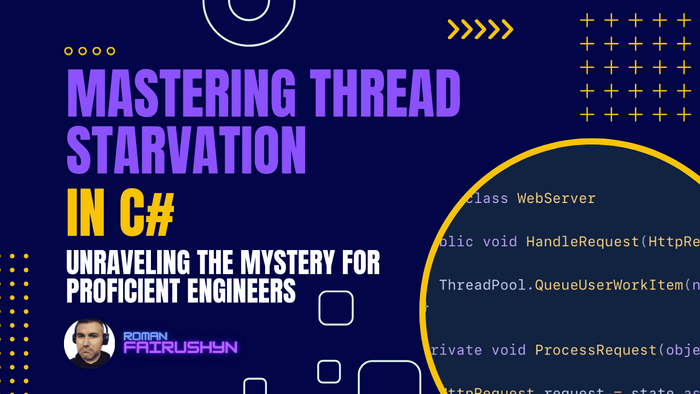Mastering Thread Starvation in C#
Unraveling the Mystery for Proficient Engineers
3 min read · — #csharp-interview#senior#thread-starvation
Introduction: In the vast realm of concurrent programming, myriad challenges lie waiting to ambush the unwary engineer. Among these, thread starvation stands as a silent but potent saboteur, often unnoticed until it wreaks havoc on application performance. Even seasoned engineers might inadvertently create conditions leading to this phenomenon, with the system ending up in a paralyzed or severely degraded state. The goal of this post is not only to decode the enigma of thread starvation but also to equip you with the strategies and tools to combat it effectively. Let's embark on this enlightening journey, showcasing practical scenarios and tips to mitigate the risks associated with thread starvation.
1. What is Thread Starvation?
Thread starvation occurs when a thread is perpetually denied access to resources, preventing it from making progress. Even if the system is not entirely frozen, this can lead to significant delays in task execution.
2. Causes of Thread Starvation in C#:
-
Priority Inversion: When a low-priority thread holds a resource needed by a high-priority thread, and an intermediate-priority thread preempts the low-priority one, leading to an unintentional delay for the high-priority thread.
var lowPriority = new Thread(() => { /* Resource holding and processing */ }); lowPriority.Priority = ThreadPriority.Lowest; var highPriority = new Thread(() => { /* Needs the resource held by lowPriority */ }); highPriority.Priority = ThreadPriority.Highest; lowPriority.Start(); highPriority.Start(); -
Contention for Shared Resources: Multiple threads vying for the same resource can lead to some threads waiting indefinitely.
static object sharedLock = new object(); void ResourceIntensiveTask() { lock (sharedLock) { // Prolonged resource operation } }
3. Identifying Thread Starvation:
Use performance monitoring tools or logging mechanisms to detect prolonged wait times or increased thread contention.
4. Mitigating Thread Starvation:
-
Fair Locking Mechanisms: Use locks that ensure fairness, ensuring every thread gets a chance to access the resource. Consider using
Monitorwith theEntermethod that supports fairness or other constructs likeSemaphoreSlim.static SemaphoreSlim semaphore = new SemaphoreSlim(1, 1); void FairResourceAccess() { semaphore.Wait(); try { // Access shared resource } finally { semaphore.Release(); } } -
Thread Pooling: Utilize thread pools, such as the
ThreadPoolin C#, which manage and reuse threads efficiently, ensuring that no thread remains idle for too long.ThreadPool.QueueUserWorkItem((state) => { // Perform task }); -
Balanced Thread Priorities: Be cautious when assigning thread priorities. Ensure that the prioritization does not lead to the sidelining of certain threads completely.
-
Limiting Resource Access Time: Ensure that threads don’t hold onto shared resources for prolonged periods, causing others to wait indefinitely.
Conclusion: Thread starvation, while subtle, can dramatically impact the responsiveness and throughput of an application. As engineers striving for excellence, understanding this phenomenon, its causes, and the techniques to circumvent it, is pivotal. With the strategies delineated above, you're well-equipped to construct applications that are both robust and performant, adeptly navigating the intricacies of concurrent programming in C#.
References:
